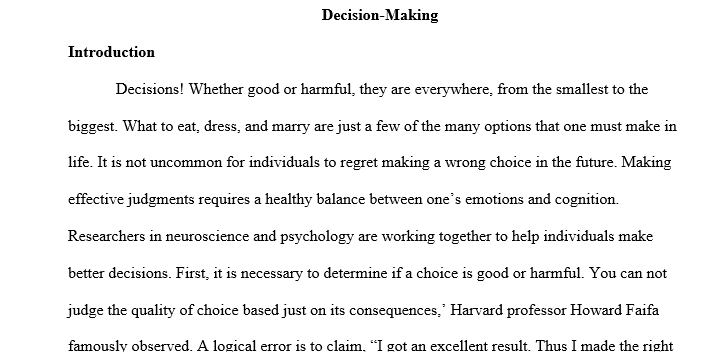name the best and worst decision you’ve ever made, describing how you reached each decision, and comment on what, if anything, you would
At about 8:15 minutes into the assigned MP3 audio, Useem describes a fire team arriving on scene to fight a forest fire in Alaska. A young guy named Tom Boatner, eager, 21 years old, is up in Alaska and part of a fire crew that is coming on a set of trucks to an area, sort of in the shadow of one of the great mountain ranges of Alaska.
As he arrives, the place is wild, chaotic. Flames are rushing up hills. There’s a very strong wind coming off the mountains. There are four or five different fire sites. He jumps out of that truck, young guy, eager, set to go, trained. He is just charged with adrenaline and ready for bear, so to speak. But his boss, 29-year-old Robert Burritt, a more experienced guy, says, “Hold on, everybody. I know you want to charge over there and get those shovels and those hoses on those flames. Don’t
do that.
Bob Burritt brought over Tom Boatner and the other members of his fire crew. These are wild-land firefighters, U.S. Forest Service. And Burritt just stood there. He just literally stood there, as if there was plenty of time, nothing going on: the look of total cool. And then he very methodically began to ask people on the fire team: “What’s going on? What do you see? Where’s the fire going? What’s the wind doing? What’s the texture of the ground material?” After about 10 or 15 minutes of careful data gathering and a working through, Bob Burritt said, “Okay, here’s what our plan is.” And he said, “I want this team to go over to that fire, this team over here. In 25 minutes you’re going to report back to me. We’ll evolve our thinking and decision making in due course.”
I mention that because Tom Boatner was stunned by the slowness of his boss at that time — not that much older than he was — in getting on the fire. But he appreciated by the end of that brief commentary or set up of the moment, that the role of the decision maker with responsibility is to appraise, know what’s happening, what the resources are, and then have a plan. You’ve got to be methodical about your decision making, and that to me, anyway, is sort of an emblem or a symbol of how many of us have learned how to make decisions. We’ve watched people who are our superiors, maybe some people we work with, who as you witness what they do, they are sometimes terrible, they are sometimes awesome. But as decision makers you learn from them some life lessons for yourself.
Today, Tom Boatner is one of America’s great Incident Commanders. That is, he will have in the field sometimes hundreds, sometimes thousands of firefighters who report to him. He has said — and I spent a good bit of time with him on this directly — that “…whenever I get into a fire zone and I know resources are limited, lives are at risk, I think, ‘Robert Burritt.’ It cools me; it gets me to focus. I stand there, I appraise, I pull data together and then I say, ‘Now, let’s go.’
For this paper, name the best and worst decision you’ve ever made, describing how you reached each decision, and comment on what, if anything, you would change about how each decision was arrived at.
Answer preview for name the best and worst decision you’ve ever made, describing how you reached each decision, and comment on what, if anything, you would

938 Words